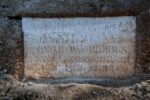 The unique tomb of a freedman whose remains are partially mummified has been unearthed in the Porta Sarno necropolis just outside the east gate of Pompeii’s city walls. Laid to rest in the decades preceding the eruption of Vesuvius, the body is one of the best preserved ever found in Pompeii.
The unique tomb of a freedman whose remains are partially mummified has been unearthed in the Porta Sarno necropolis just outside the east gate of Pompeii’s city walls. Laid to rest in the decades preceding the eruption of Vesuvius, the body is one of the best preserved ever found in Pompeii.
 The tomb is a masonry walled enclosure with a triangular pediment. Traces of polychrome paint survive on the exterior. It is faded, but seems to have been a garden scene. The deceased was inhumed in a small cell behind the main façade that was so effectively sealed that organic remains were preserved, including part of one ear, his hair and numerous textile fragments.
The tomb is a masonry walled enclosure with a triangular pediment. Traces of polychrome paint survive on the exterior. It is faded, but seems to have been a garden scene. The deceased was inhumed in a small cell behind the main façade that was so effectively sealed that organic remains were preserved, including part of one ear, his hair and numerous textile fragments.
 An inscription on a marble slab embedded in the pediment identifies the deceased as Marcus Venerius Secundio, a former public slave employed as the custodian of the Temple of Venus and as an attendant of the Augustali, the order of priests dedicated to the cult of the Divine Augustus and the Julii. After he was manumitted, he came to hold prominent religious and political positions in Pompeii. He became an Augustale, joining the priesthood he had once served, and he “gave Greek and Latin ludi the lasted for four days.” There are inscriptions in Greek and of course the Roman elite spoke it, but this inscription is the first direct evidence of a spectacle in Pompeii having been staged in the Greek language.
An inscription on a marble slab embedded in the pediment identifies the deceased as Marcus Venerius Secundio, a former public slave employed as the custodian of the Temple of Venus and as an attendant of the Augustali, the order of priests dedicated to the cult of the Divine Augustus and the Julii. After he was manumitted, he came to hold prominent religious and political positions in Pompeii. He became an Augustale, joining the priesthood he had once served, and he “gave Greek and Latin ludi the lasted for four days.” There are inscriptions in Greek and of course the Roman elite spoke it, but this inscription is the first direct evidence of a spectacle in Pompeii having been staged in the Greek language.
 Inhumation was a rare funerary practice for Roman adults in the 1st century. Marcus Venerius was more than 60 years old when he died. He shared the tomb with two other individuals, only they were cremated as per standard operating procedure. Two cinerary
Inhumation was a rare funerary practice for Roman adults in the 1st century. Marcus Venerius was more than 60 years old when he died. He shared the tomb with two other individuals, only they were cremated as per standard operating procedure. Two cinerary  urns were found in the wider enclosure, not in his cell. One of them, a beautiful blue-green glass vessel, is identified by a columella (a stone funerary marker used in the Sarno Valley) with the name Novia Amabilis. Archaeologists believe she may have been Marcus’ wife.
urns were found in the wider enclosure, not in his cell. One of them, a beautiful blue-green glass vessel, is identified by a columella (a stone funerary marker used in the Sarno Valley) with the name Novia Amabilis. Archaeologists believe she may have been Marcus’ wife.
 The human and organic remains have been removed to Pompeii’s laboratory where they will be analyzed and conserved. Researchers hope to discover if this was deliberate mummification or a natural side-effect of the tomb’s hermetic seal.
The human and organic remains have been removed to Pompeii’s laboratory where they will be analyzed and conserved. Researchers hope to discover if this was deliberate mummification or a natural side-effect of the tomb’s hermetic seal.
I’ve been anxiously waiting on you to write about this!
Nearby “Naples”, a.k.a. “Napoli”, for example, is in fact “Greek”. There was Parthenope (a.k.a “Palaeo Polis”, Old Town) and “Nea Polis” (Greek for “New Town”).
This type of tomb cell is, as far as I could tell, still in use, and I am almost certain that the mummification in this case is a “side-effect of the tomb’s seal”.
Contrastingly, I read elsewhere that –in Pompeii– it had mainly been “slaves and prostitutes”, who spoke Greek.
The bit that I don’t understand is what I read as “mineorum”, i.e. of “the ones of cinnabar-red color”??? – Romani, walk the House! :boogie:
The inscription reads, seemingly:
————
“M. Venerius Coloniae Lib. Secundio aedituus [=”temple custodian”] veneris augustaeis et mineorum [?] hic solus ludos graecos et latinos quadriduo [=”for four days”] dedit.”
————
There is seemingly a “Zophar” referred to in the Old Testament, notably as the king of the Minaeans: “rex Mineorum” (in Greek σωφαρ ο μιναιων βασιλευς).
Myself, I am unable to tell, if any “Minaeans” had connections within the Roman Empire, but if so, Venerius might indeed have been imported from the East/ Orient.
Also, later Augustinus writes about “Minaeans” as ‘heretics within the Jews’: “…hodie per totas Orientis synagogas inter Iudaeos haeresis est, quae dicitur Mineorum, et a Pharisaeis nunc usque damnatur, quos vulgo..”
:confused:
@Caligula Minus:
Probably because it is part of an abbreviation: “… aedituus Veneris Augustalis et min(ister) eorum …”, meaning he was serving both the college of the Augustales and the priests of Venus. This abbreviation is attested a few times in Latin epigraphy:
He earned his freedom the hard way. Learn what you must from him but put him back and reseal the tomb. He deserves a better fate than a drawer in a museum storehouse.
Still no better explanation for the “mineorum” bit? :ohnoes:
Personally, I would like to know, if Venerius was possibly born on the Arabian peninsula, possibly around 35+BC. Some form of “Jewish or Proto-Christian” identity, moreover, might even explain the “inhumation” (i.e. instead of a cremation).
Apparently, the epistle about venerations of the “Mineorum” (genitive) was a letter TO(!) Augustinus from THIS guy: en.wikipedia.org/wiki/Jerome
Unfortunately, all that stuff is deeply hidden behind ugly “paywalls” that Jerome –certainly– wouldn’t have approved!
Vade retro, Satanas! :angry:
—
However, Jerome of the fourth century speaks of a heresy of the Jews “quae dicitur mineorum” and associates them with “Nazarenes.” He writes, “Even today in all the synagogues of the Orient, there is a sect among the Jews called Nazarenes whom the Pharisees [sic] anathematize even now” Epistle to Augustine; compare Commentary on Isa…
—
In 25/24 BC, the Roman general Aelius Gallus waged a military campaign, setting off from Egypt, against what is now Yemen, while Augustus had been reigning from 27 BC onwards. – cf.: en.wikipedia.org/wiki/Romans_in_Arabia#Aelius_Gallus_expedition
:hattip:
@Caligula Minus:
Probably because it is part of an abbreviation: “… aedituus Veneris Augustalis et min(ister) eorum …”, meaning he was a custodian of the Temple of Venus and an attendant (minister) to the college of the Augustales (probably before becoming an Augutalis himself). This abbreviation is attested a few times in Latin epigraphy:
Thanks for the feedback, fosco13
Yes, usually there is a lot of –military or not so military– “chiselled Roman shorthand” in the first place 😉
Indeed, ‘minister’ would make sense. Possibly, even in addition to the “edituus” that is already there.
‘Eorum” seems to be the masculine or neutral form, but, hey: Why not ministering Love/Venus and the Augustali?
:hattip:
——-
PS: As far as any “Minaeans” would be concerned, they might have been in what today is Yemen, but seemingly there were also place names, closer to the eastern Mediterranean (i.e. “Negev”, I understand).
Contemporary hints that a “sect” of a similar name would have played a role seem to be rather scarce. The letter to Augustine is later